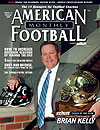Article CategoriesAFM Magazine
|
Schutt - FBS Coach of the Yearby: Mike KucharSenior Writer, American Football Monthly © More from this issue “They pay coaches bigger salaries now, so you better not waste any time getting the job done. There is always someone else in waiting.” Simply put, Brian Kelly knows how to win football games. And he can win them at any level. Just as a craftsman works his plan to the detail, Kelly has executed his formula for success at every level he’s been – from Division II Grand Valley State to mid-major Central Michigan to a former Big East doormat, the University of Cincinnati.
|
|
|||||||
| HOME |
MAGAZINE |
SUBSCRIBE | ONLINE COLUMNISTS | COACHING VIDEOS |
Copyright 2025, AmericanFootballMonthly.com
All Rights Reserved





